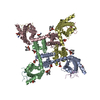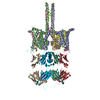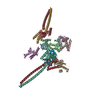[English] 日本語
 Yorodumi
Yorodumi- PDB-6n4q: CryoEM structure of Nav1.7 VSD2 (actived state) in complex with t... -
+ Open data
Open data
- Basic information
Basic information
| Entry | Database: PDB / ID: 6n4q | ||||||
|---|---|---|---|---|---|---|---|
| Title | CryoEM structure of Nav1.7 VSD2 (actived state) in complex with the gating modifier toxin ProTx2 | ||||||
 Components Components |
| ||||||
 Keywords Keywords | MEMBRANE PROTEIN / voltage-gated sodium channel / gating modifier toxin | ||||||
| Function / homology |  Function and homology information Function and homology informationaction potential propagation / detection of mechanical stimulus involved in sensory perception / cardiac muscle cell action potential involved in contraction / node of Ranvier / voltage-gated sodium channel complex / Interaction between L1 and Ankyrins / voltage-gated sodium channel activity / detection of temperature stimulus involved in sensory perception of pain / Phase 0 - rapid depolarisation / behavioral response to pain ...action potential propagation / detection of mechanical stimulus involved in sensory perception / cardiac muscle cell action potential involved in contraction / node of Ranvier / voltage-gated sodium channel complex / Interaction between L1 and Ankyrins / voltage-gated sodium channel activity / detection of temperature stimulus involved in sensory perception of pain / Phase 0 - rapid depolarisation / behavioral response to pain / sodium channel regulator activity / neuronal action potential / axon terminus / sensory perception of pain / sodium ion transmembrane transport / post-embryonic development / calcium channel regulator activity / circadian rhythm / response to toxic substance / Sensory perception of sweet, bitter, and umami (glutamate) taste / toxin activity / inflammatory response / axon / lipid binding / extracellular region / metal ion binding / identical protein binding / plasma membrane Similarity search - Function | ||||||
| Biological species |  Arcobacter butzleri (bacteria) Arcobacter butzleri (bacteria) Homo sapiens (human) Homo sapiens (human)  Thrixopelma pruriens (green velvet) Thrixopelma pruriens (green velvet) | ||||||
| Method | ELECTRON MICROSCOPY / single particle reconstruction / cryo EM / Resolution: 3.6 Å | ||||||
 Authors Authors | Xu, H. / Rohou, A. / Arthur, C.P. / Estevez, A. / Ciferri, C. / Payandeh, J. / Koth, C.M. | ||||||
 Citation Citation |  Journal: Cell / Year: 2019 Journal: Cell / Year: 2019Title: Structural Basis of Nav1.7 Inhibition by a Gating-Modifier Spider Toxin. Authors: Hui Xu / Tianbo Li / Alexis Rohou / Christopher P Arthur / Foteini Tzakoniati / Evera Wong / Alberto Estevez / Christine Kugel / Yvonne Franke / Jun Chen / Claudio Ciferri / David H Hackos / ...Authors: Hui Xu / Tianbo Li / Alexis Rohou / Christopher P Arthur / Foteini Tzakoniati / Evera Wong / Alberto Estevez / Christine Kugel / Yvonne Franke / Jun Chen / Claudio Ciferri / David H Hackos / Christopher M Koth / Jian Payandeh /  Abstract: Voltage-gated sodium (Nav) channels are targets of disease mutations, toxins, and therapeutic drugs. Despite recent advances, the structural basis of voltage sensing, electromechanical coupling, and ...Voltage-gated sodium (Nav) channels are targets of disease mutations, toxins, and therapeutic drugs. Despite recent advances, the structural basis of voltage sensing, electromechanical coupling, and toxin modulation remains ill-defined. Protoxin-II (ProTx2) from the Peruvian green velvet tarantula is an inhibitor cystine-knot peptide and selective antagonist of the human Nav1.7 channel. Here, we visualize ProTx2 in complex with voltage-sensor domain II (VSD2) from Nav1.7 using X-ray crystallography and cryoelectron microscopy. Membrane partitioning orients ProTx2 for unfettered access to VSD2, where ProTx2 interrogates distinct features of the Nav1.7 receptor site. ProTx2 positions two basic residues into the extracellular vestibule to antagonize S4 gating-charge movement through an electrostatic mechanism. ProTx2 has trapped activated and deactivated states of VSD2, revealing a remarkable ∼10 Å translation of the S4 helix, providing a structural framework for activation gating in voltage-gated ion channels. Finally, our results deliver key templates to design selective Nav channel antagonists. | ||||||
| History |
|
- Structure visualization
Structure visualization
| Movie |
 Movie viewer Movie viewer |
|---|---|
| Structure viewer | Molecule:  Molmil Molmil Jmol/JSmol Jmol/JSmol |
- Downloads & links
Downloads & links
- Download
Download
| PDBx/mmCIF format |  6n4q.cif.gz 6n4q.cif.gz | 362.1 KB | Display |  PDBx/mmCIF format PDBx/mmCIF format |
|---|---|---|---|---|
| PDB format |  pdb6n4q.ent.gz pdb6n4q.ent.gz | 298.5 KB | Display |  PDB format PDB format |
| PDBx/mmJSON format |  6n4q.json.gz 6n4q.json.gz | Tree view |  PDBx/mmJSON format PDBx/mmJSON format | |
| Others |  Other downloads Other downloads |
-Validation report
| Arichive directory |  https://data.pdbj.org/pub/pdb/validation_reports/n4/6n4q https://data.pdbj.org/pub/pdb/validation_reports/n4/6n4q ftp://data.pdbj.org/pub/pdb/validation_reports/n4/6n4q ftp://data.pdbj.org/pub/pdb/validation_reports/n4/6n4q | HTTPS FTP |
|---|
-Related structure data
| Related structure data |  0341MC  0342C  6n4iC  6n4rC M: map data used to model this data C: citing same article ( |
|---|---|
| Similar structure data | |
| EM raw data |  EMPIAR-10261 (Title: CryoEM micrographs of ProTx2-bound Nav1.7 VSD2-NavAb chimeric channel EMPIAR-10261 (Title: CryoEM micrographs of ProTx2-bound Nav1.7 VSD2-NavAb chimeric channelData size: 2.8 TB Data #1: First dataset - raw, compressed, non-gain-corrected, integer frames [micrographs - multiframe] Data #2: Second dataset - raw, compressed, non-gain-corrected, integer frames [micrographs - multiframe]) |
- Links
Links
- Assembly
Assembly
| Deposited unit | 
|
|---|---|
| 1 |
|
- Components
Components
| #1: Protein | Mass: 33453.512 Da / Num. of mol.: 4 Source method: isolated from a genetically manipulated source Source: (gene. exp.)  Arcobacter butzleri (strain RM4018) (bacteria), (gene. exp.) Arcobacter butzleri (strain RM4018) (bacteria), (gene. exp.)  Homo sapiens (human) Homo sapiens (human)Strain: RM4018 / Gene: Abu_1752, SCN9A, NENA / Production host:  Trichoplusia ni (cabbage looper) / References: UniProt: A8EVM5, UniProt: Q15858 Trichoplusia ni (cabbage looper) / References: UniProt: A8EVM5, UniProt: Q15858#2: Protein/peptide | Mass: 3839.687 Da / Num. of mol.: 4 / Source method: obtained synthetically / Source: (synth.)  Thrixopelma pruriens (green velvet) / References: UniProt: P83476 Thrixopelma pruriens (green velvet) / References: UniProt: P83476#3: Antibody | Mass: 23483.910 Da / Num. of mol.: 2 / Source method: isolated from a natural source / Source: (natural)  #4: Antibody | Mass: 24523.518 Da / Num. of mol.: 2 / Source method: isolated from a natural source / Source: (natural)  Has protein modification | Y | |
|---|
-Experimental details
-Experiment
| Experiment | Method: ELECTRON MICROSCOPY |
|---|---|
| EM experiment | Aggregation state: PARTICLE / 3D reconstruction method: single particle reconstruction |
- Sample preparation
Sample preparation
| Component | Name: Nav1.7 VSD2 in complex with ProTx2 and an anti-Nav Fab Type: COMPLEX / Entity ID: all / Source: MULTIPLE SOURCES |
|---|---|
| Molecular weight | Value: 0.245 MDa / Experimental value: NO |
| Source (natural) | Organism:  Homo sapiens (human) Homo sapiens (human) |
| Source (recombinant) | Organism:  Trichoplusia ni (cabbage looper) Trichoplusia ni (cabbage looper) |
| Buffer solution | pH: 8 Details: 10 mM Tris pH 8.0, 100 mM NaCl, 0.06% FA3, 0.1 mg/ml POPC:POPE:POPG mixed at molar ratio 3:1:1 |
| Specimen | Conc.: 2 mg/ml / Embedding applied: NO / Shadowing applied: NO / Staining applied: NO / Vitrification applied: YES |
| Specimen support | Details: Grid was coated with a thin layer of gold / Grid material: COPPER / Grid mesh size: 300 divisions/in. / Grid type: C-flat-1.2/1.3 |
| Vitrification | Instrument: FEI VITROBOT MARK IV / Cryogen name: ETHANE / Humidity: 100 % / Chamber temperature: 277 K / Details: Apply 3 uL, blot 2.5s. Ted Pella 595 filter paper. |
- Electron microscopy imaging
Electron microscopy imaging
| Experimental equipment |  Model: Titan Krios / Image courtesy: FEI Company |
|---|---|
| Microscopy | Model: FEI TITAN KRIOS |
| Electron gun | Electron source:  FIELD EMISSION GUN / Accelerating voltage: 300 kV / Illumination mode: FLOOD BEAM FIELD EMISSION GUN / Accelerating voltage: 300 kV / Illumination mode: FLOOD BEAM |
| Electron lens | Mode: BRIGHT FIELD / Nominal magnification: 165000 X / Nominal defocus max: 2500 nm / Nominal defocus min: 1000 nm / Cs: 2.7 mm / C2 aperture diameter: 100 µm / Alignment procedure: COMA FREE |
| Specimen holder | Cryogen: NITROGEN / Specimen holder model: FEI TITAN KRIOS AUTOGRID HOLDER |
| Image recording | Average exposure time: 10 sec. / Electron dose: 41 e/Å2 / Detector mode: COUNTING / Film or detector model: GATAN K2 SUMMIT (4k x 4k) / Num. of grids imaged: 1 / Num. of real images: 25084 |
| EM imaging optics | Energyfilter name: GIF Bioquantum / Energyfilter slit width: 20 eV |
| Image scans | Movie frames/image: 40 |
- Processing
Processing
| EM software |
| ||||||||||||||||||||||||||||||||
|---|---|---|---|---|---|---|---|---|---|---|---|---|---|---|---|---|---|---|---|---|---|---|---|---|---|---|---|---|---|---|---|---|---|
| CTF correction | Type: PHASE FLIPPING AND AMPLITUDE CORRECTION | ||||||||||||||||||||||||||||||||
| Symmetry | Point symmetry: C2 (2 fold cyclic) | ||||||||||||||||||||||||||||||||
| 3D reconstruction | Resolution: 3.6 Å / Resolution method: FSC 0.143 CUT-OFF / Num. of particles: 187192 Details: Spatial frequencies higher than 8 Angstroms were not used during refinement. Symmetry type: POINT |
 Movie
Movie Controller
Controller








 PDBj
PDBj






